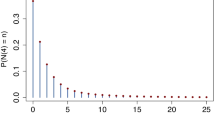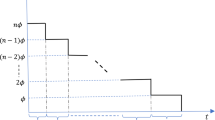Abstract
A nonhomogeneous Poisson process (NHPP) plays an important role in a variety of applications as reliability of repairable systems, software reliability and actuarial studies. An NHPP is characterized by its intensity function m(t), which provides information on the time-dependent nature of the reliability of the system. Various intensity functions, which describe different behavior (from reliability decay to reliability growth along with monotonicity, convexity or concavity), have been suggested for NHPP’s for modeling repairable systems. Perhaps one of the most frequently utilized NHPP is the power lawprocess (PLP) in which m(t) is a power function of t. Inthis studywe present a general method for constructing new intensity functions for NHPP’s yielding new classes of NHPP’s. This method utilizes certain operators L n , n ∈ N0, acting on some suitable functions L 0 = f (termed base functions). We call these classesOBIF’s (operator-based intensity functions). These classes are represented in terms of three parameters of which one is an indexing parameter n ∈ N0 and two others are scale and shape parameters. The fact that n ∈ N0 is also a parameter provides a flexibility in the choice of the appropriate statistical model for NHPP’s data. In particular, we consider the exponential operator acting on the PLP intensity function f and realize that L n ’s, n ≥ 2, inherit properties similar to those of L 1 (convexity and concavity) and thus are suitable for modelling bathtub data. We also consider a more comprehensive treatment of OBIF classes where both, the operator and base functions, are general. All of the introduced operators are demonstrated with illustrative examples.
Similar content being viewed by others
References
T. Aven and U. Jensen, Stochastic Models in Reliability (Springer-Verlag, New York, 1999).
B. Benjamin and J. H. Pollard, The Analysis of Mortality and Other Actuarial Statistics (Heinemann, London, 1986).
J. L. Coetzee, “Reliability Degradation and Equipment Replacement Problem”, in Proc. Internat. Conf. of Maintenance Societies (ICOMS-96) Melbourne, Paper 21 (1996).
M. Karbasian and Z. Ibrahim, “Estimation of Parameters of the Power-Law-Non-Homogeneous Poisson Process in the Case of Exact Failures Data”, Internat. J. Industr. Engineering and Production Research 21, 105–110 (2010).
U. Kumar, B. Klefsjö, and S. Granholm, “Reliability Investigation for a Fleet of Load Haul Dump Machines in SwedishMine”, Reliability Engineering and System Safety 26, 341–361 (1989).
R. Lai and M. Garg, “A Detailed Study of NHPP Software Reliability Models”, J. Software 7, 1296–1306 (2012).
B. H. Lindqvist, “On the Statistical Modeling and Analysis of Repairable Systems”, Statist. Sci. 21 (4), 532–531 (2006).
S. E. Rigdon and A. P. Basu, Statistical Methods for the Reliability of Repairable Systems (Wiley, New York, 2000).
K. Muralidharan, “A Review of Repairable Systems and Point ProcessModels”, in ProbStat Forum (2006), Vol. 1, pp. 26–49.
J. D. Musa and K. Okumoto, “A Logarithmic Poisson Execution Time Model for Software Reliability Measurements”, in Proc. Seventh Internat. Conf. on Software Engineering (1984), pp. 230–238.
J. D. Nielsen and C. B. Dean, “Adaptive FunctionalMixedNHPPModels for theAnalysis of RecurrentEvent Panel Data”, Comput. Statist. and Data Analysis 52 (7), 3670–365 (2008).
H. Okamura, M. Grottke, T. Dohi, and K. S. Trivedi, “Variational Bayesian Approach for Interval Estimation of NHPP-Based Software ReliabilityModels”, in 37th Annual IEEE/IFIP Internat. Conf. on Dependable Systems and Networks (DSN’07), (Publisher IEEE, 2007), DOI:10.1109/DSN.2007.101.
G. Pulcini, “Modeling the Failure Data of a Repairable Equipment with Bathtub Type Failure Intensity”, Reliability Engineering and System Safety 71, 209–218 (2001).
K. J. Ryan, “Some Flexible Families of Intensities for Nonhomogeneous Poisson Process Models and Their Bayes Estimates”, Quality and Reliability Engineering International 19, 171–181 (2003).
K. J. Ryan, M. S. Hamada, and C. Shane Reese, “A Bayesian Hierarchical Power Law Model for Multiple Repairable Systems with an Application to Supercomputer Reliability”, J. Quality Technol. 43 (3), 183–198 (2011).
F. Ruggeri, On the Reliability of Repairable Systems: Methods and Applications Techn. Rep. 18-MI (CNR-IMATI, Milano, 2004).
F. Ruggeri and A. Pievatolo, “Bayesian Reliability Analysis of Complex Repairable Systems”, Appl. Stoch. Models in Business and Industry 20, 253–264 (2004).
F. Ruggeri and S. Sivaganesan, “On Modeling Change Points in Non-Homogeneous Poisson Processes”, Statist. Inference for Stochastic Processes 8, 311–329 (2005).
A. Syamsundar and V. N. A. Naikan, “Sequential Detection of Change Points forMaintained SystemsUsing SegmentedModels”, Quality and Reliability Engineering International 25, 739–757 (2009).
F.-K. Wang and Y.-C. Lu, “A New Bounded Intensity Function for Repairable Systems”, J. Industrial and Production Engineering 31, 36–40 (2014).
J. Weinberg, L. D. Brown, and J. R. Stroud, “Bayesian Forecasting of an Inhomogeneous Poisson Process with Applications to Call Center Data”, J. Amer. Statist. Assoc. 102 (480), 1185–1198 (2007).
J. S. Weitz and H. B. Fraser, “Explaining Mortality Rate Plateaus”, Proc. Nat. Acad. Sci. U.S.A. 98 (26), 15383–15386 (2001).
T. J. Yang and H.-C. Kim, “Growth Model Based on the Intensity Function of Log-Linear and Log-Power Forms”, Smart Computing Review 4 (6), 451–458 (2014).
M. Zhao, “Superposition of Power-Law Models for Hardware/Software Reliability Data”, Internat. J. Reliability, Quality and Safety Engineering 10, 25–45 (2003).
Author information
Authors and Affiliations
Corresponding author
About this article
Cite this article
Bar-Lev, S.K., Bshouty, D. & van der Duyn Schouten, F.A. Operator-based intensity functions for the nonhomogeneous Poisson process. Math. Meth. Stat. 25, 79–98 (2016). https://doi.org/10.3103/S1066530716020010
Received:
Accepted:
Published:
Issue Date:
DOI: https://doi.org/10.3103/S1066530716020010




